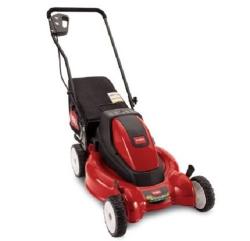 Electric lawn mowers are not new to the lawn – the first ones to hit the consumer market came out almost a century ago. However, they were never very popular, and only achieved minor success. With the growth of green technology and the push for better, cleaner ways to perform daily activities, the electric mower is beginning to make a comeback. They combine the clean power and quiet operation of the reel mower with the cutting efficiency of a conventional gas-powered push mower. They are beginning to gain traction in the market, and are becoming increasingly popular, especially in urban and suburban areas with smaller lawns. So how do electric mowers stack up against their reel mower and conventional mower counterparts?
Electric lawn mowers are not new to the lawn – the first ones to hit the consumer market came out almost a century ago. However, they were never very popular, and only achieved minor success. With the growth of green technology and the push for better, cleaner ways to perform daily activities, the electric mower is beginning to make a comeback. They combine the clean power and quiet operation of the reel mower with the cutting efficiency of a conventional gas-powered push mower. They are beginning to gain traction in the market, and are becoming increasingly popular, especially in urban and suburban areas with smaller lawns. So how do electric mowers stack up against their reel mower and conventional mower counterparts?
Convenience
It’s hard to beat the convenience of the reel mower – you just grab it and start walking. Nothing to fiddle with, no keys to turn, cords to pull or levers to move. It doesn’t have batteries to charge or a tank that will need refueling. It is light and easy to push, and is clearly the convenience champ. The typical electric mower will have a button to push or a key to turn to start, as well as a safety bar or lever to engage the mower blade, and that will automatically disengage the blade if it is left go of. Conventional mowers have the fun of fiddling with priming buttons, adjusting gas flow, and yanking on a cord over and over until you get it to turn over.
Power
Clearly the major differences between the types of push mowers are what makes the blades go around. The reel mower, well, it’s all you. You’re not just pushing it along, it’s the friction caused by you pushing it that makes the blades move. This is quiet and efficient, although there can be some issues with loose soil or bumpy lawns, as the loss of traction will stop the blades from turning. Reel mowers also sometimes have difficulty working through high grass and brush, due to the relatively low cutting speed of the blades.
Conventional and electric mowers both cut the grass the same way, with the rotating blades underneath the mower deck. The electric mowers come in corded or cordless versions, powering a small electric mower that turns the blades. These motors are sometimes a bit underpowered for larger tasks such as high lawns and twigs, and they will sometimes have to fight to get through it. Cordless versions are more convenient, because you don’t have to take care to avoid the cord, but the batteries often run low quickly, and aren’t good for more than around 30 minutes of cutting time. Corded versions have constant power, but you have to work out getting around the cord.
Conventional mowers have plenty of power, able to cut through tough areas and high grasses, but the gas engines produce pollutants and noise much greater than reel or electric mowers. They will provide the most consistent mowing speed, and some of them are self-propelled, meaning you merely need to guide it. The propulsion area is a spot where electric mowers still haven’t quite figured things out, but its only a matter of time.
Price
This is where the electric mower still trails the other two types. The average electric mowers will cost a bit more than a conventional lawn mower, and a lot more than even some of the high-end reel mowers. The more powerful, cordless electric mowers can run above $500, pushing close to riding mower territory. Conversely, reel mowers can be found for almost nothing, while conventional mowers fall in between. For instance, the Toro e-Cycler generally runs almost $150 more than the equivalent conventionally powered Toro 20″ Push Mower, while a reel mower with the same cut width will run under $100. However, over the long run, the electric mower will be cheaper to operate than the gas-powered mower and will not need the constant maintenance of the reel mower.
Intangibles
If you want to feel better about how you treat the environment, electric mowers still aren’t tops, but they’re the only way you’ll get a push-mower cut without sucking in exhaust fumes all day. If you’re supremely lazy, there are also robotic electric mowers, where you set up boundary wires and set the mower up, then let it go do its thing while you kick back and relax. Electric mowers also have the advantage of having an eye to the future, and they will likely only improve, while reel and conventional push mowers have little room for improvement.






